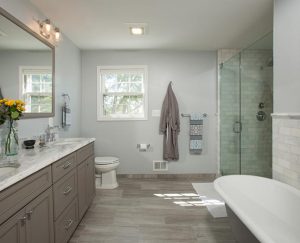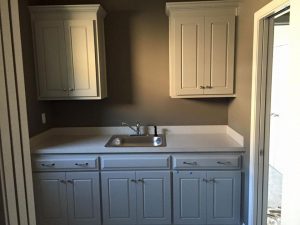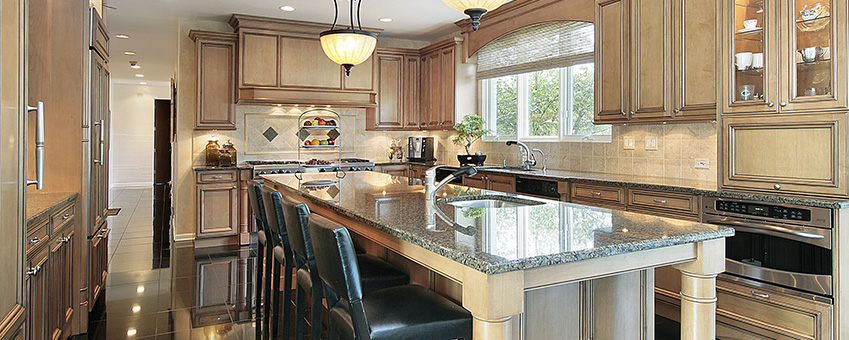Does Your Bathroom and Kitchen Have to Match?
When it comes to home design, one of the perennial questions that homeowners grapple with is whether the bathroom and kitchen should match. These two spaces are integral to any home, serving both functional and aesthetic purposes. Let’s delve into the world of interior design and explore whether cohesion between the bathroom and kitchen is a necessity or a matter of personal preference.
The Case for Matching: Cohesive Aesthetics
For those who value a sense of continuity and flow throughout their home, matching the bathroom and kitchen can create a cohesive aesthetic. This design choice often involves using similar color palettes, materials, and styles in both spaces. The idea is to create a harmonious visual experience for residents and guests alike.
A matching design can be particularly effective in open floor plans where the kitchen and bathroom are in close proximity. Consistent elements, such as cabinet finishes, countertop materials, or tile choices, can tie these spaces together seamlessly. This approach is not just about aesthetics; it’s about creating a unified atmosphere that promotes a sense of balance and tranquility.
Color Palette and Material Harmony
When considering a matched design, focus on the color palette and materials used in both the kitchen and bathroom. For example, if your kitchen features warm, earthy tones and wooden finishes, extending these elements to the bathroom can establish a visual connection between the two spaces.

Harmonizing materials, such as using the same type of countertop material in both areas, can reinforce the sense of unity. This approach doesn’t mean everything must be identical; subtle variations can add interest while still maintaining an overall cohesive look.
The Argument for Contrast: Embracing Individuality
On the flip side, there’s a growing trend toward embracing diversity in home design. Many homeowners are choosing to forgo a strictly matched approach, opting instead for contrasting styles between the kitchen and bathroom. This can be a bold design choice that allows each space to stand out independently.
Distinctive Styles and Personal Expression
Contrasting the kitchen and bathroom allows for more creative freedom and personal expression. Each room can have its own unique style, reflecting the preferences and personality of the inhabitants. This approach is particularly popular among those who enjoy experimenting with different design trends and are not afraid to showcase their eclectic taste.
Embracing distinctive styles doesn’t mean complete chaos; some elements can still be shared for a subtle connection. For instance, coordinating fixtures or selecting a common theme, such as a shared color accent, can provide a sense of unity without compromising individuality.
Practical Considerations: Functionality Over Matching
While aesthetics play a significant role in design decisions, functionality should not be overlooked. The kitchen and bathroom serve different purposes, and their designs should prioritize practicality and convenience.
Functionality in the Kitchen
The kitchen is often considered the heart of the home, and its design should prioritize functionality. Matching the kitchen with the bathroom may not always make sense, especially if it hinders the efficiency of the cooking and dining space. In the kitchen, considerations such as storage, countertop space, and easy navigation take precedence.
Practicality in the Bathroom
Similarly, the bathroom has specific functional requirements that may differ from those of the kitchen. Elements like waterproof surfaces, proper ventilation, and ample storage for toiletries are key considerations. While some design elements can be shared between the kitchen and bathroom, it’s crucial to prioritize practicality in each space independently.
Finding the Middle Ground: Cohesion with Flexibility
For those torn between a perfectly matched design and a more eclectic approach, finding a middle ground can offer the best of both worlds. This involves maintaining a certain level of cohesion while allowing for individuality and practical considerations.

Common Elements and Focal Points
Identify common elements that can be shared between the kitchen and bathroom. This could be a shared color scheme, a particular material, or even a consistent design theme. By establishing these commonalities, you create a thread that ties the two spaces together without sacrificing their unique identities.
Consider incorporating focal points in each space that draw attention and create visual interest. This could be a statement backsplash in the kitchen or a unique vanity in the bathroom. These focal points can become the anchors for each room, providing a sense of connection while allowing for diversity.
Conclusion: Your Home, Your Style
In the end, the decision of whether your bathroom and kitchen should match comes down to personal preference. There’s no one-size-fits-all answer, and the beauty of interior design lies in its subjectivity. Whether you choose a cohesive, matching design or embrace contrasting styles, the most important factor is that your home reflects your unique taste and meets the practical needs of your lifestyle. So, let your creativity flow, and design a home that truly feels like yours. https://sydneyhomesandrenovations.com.au/kitchen-laundry-bathroom-renovations/

